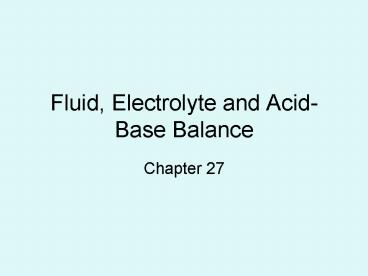Fluid, Electrolyte and AcidBase Balance - PowerPoint PPT Presentation
1 / 31
Title:
Fluid, Electrolyte and AcidBase Balance
Description:
Fluid, Electrolyte and Acid-Base Balance. Chapter 27. Body mass: solid vs fluid. Where's the water? ... Burns. Vomiting. Diarrhea. Sweating ... – PowerPoint PPT presentation
Number of Views:35
Avg rating:3.0/5.0
Title: Fluid, Electrolyte and AcidBase Balance
1
Fluid, Electrolyte and Acid-Base Balance
- Chapter 27
2
Body mass solid vs fluid
3
Wheres the water?
4
Water content varies with age tissue type
- Infants 73
- Adult male 60
- Adult female 50
- Elderly 45
- Fat has the lowest water content (20).
- Bone is close behind (22 25).
- Skeletal muscle is highest at 65.
5
Electrolyte concentrations are calculated in
milliequivalents
mEq/L ion concentration (mg/L) x number of
charges on one ion atomic weight
Na concentration in the body is 3300 mg/L Na
carries a single positive charge. Its atomic
weight is approximately 23. Therefore, in a
human the normal value for Na is 3300 mg/L
143 mEq/L 23
Note One mEq of a univalent is equal to one mOsm
whereas one mEq of a bivalent ion is equal to ½
mOsm. However, the reactivity of 1 mEq is equal
to 1 mEq.
6
Relative electrolyte concentrationsPlasma,
Interstitial Fluid ICF
7
Sources of intake output
8
Regulation of water balance
- It is not so much water that is regulated, but
solutes. - osmolality is maintained at between 285 300
mOsm. - An increase above 300 mOsm triggers
- Thirst
- Antidiuretic Hormone release
9
The Thirst Mechanism
An increase of 2 3 in plasma osmolality
triggers the thirst center of the
hypothalamus. Secondarily, a 10 15 drop in
blood volume also triggers thirst. This is a
significantly weaker stimulus.
10
Sodium influence on blood volume
11
Sodium regulation
12
Dehydration
- Chronic dehydration leads to oliguria.
- Severe dehydration can result in hypovolemic
shock. - Causes include
- Hemorrhage
- Burns
- Vomiting
- Diarrhea
- Sweating
- Diuresis, which can be caused by diabetes
insipidus, diabetes mellitus and hypertension
(pressure diuresis).
13
Hypotonic hydration
- A severe drop in osmolality
- Caused by
- Excessive water intake
- Renal dysfunction
- Major consequence is hyponatremia.
- Hyponatremia results in
- Cerebral edema (brain swelling)
- Sluggish neural activity
- Convulsions, muscle spasms, deranged behavior.
- Treated with I.V. hypertonic mannitol or
something similar.
14
Hypotonic hydration
15
A rather lame illustrationYou do remember how
osmosis works, dont you?
16
Blood pressure, sodium, and water
17
Atrial Naturetic PeptideThe hearts own
compensatory mechanism.
18
What a buffer
- Acids are proton donors
- Bases are proton acceptors
- Strong acids bases dissociate completely
- Acid buffer systems are comprised of compounds
that resist pH changes by accepting protons from
solutions containing strong acids. - Base buffer systems accept OH- ions from
solutions. (Not discussed in the text).
19
Chemical Buffer Systems
- KEY CONCEPTS
- 1. The major fluid compartments of the body are
the extracellular fluid compartment (EFC), which
includes the plasma and interstitial fluid, and
the intracellular fluid compartment (IFC). About
33 of the body fluid is ECF and 67 is ICF.
20
Chemical Buffers key concepts
- 2. The body controls the ECF osmolarity and the
ECF volume through the plasma compartment, even
though it is only 7 of the total body fluids.
21
Chemical Buffers key concepts
- 3. Regulating pH at about 7.4 is important for
normal cellular function. pH is a log scale of
relative amounts of H and OH-. The scale runs
from 0 (acidic) to 14 (basic) with 7 being
neutral (having an equal amount of H and OH-
ions). Buffers, such as Hb, other proteins,
phosphates, and bicarbonates, are substances
which cushion a solution from abrupt pH changes.
22
Chemical Buffers key concepts
- 4. The lung and the distal tubules of the kidney
are responsible for regulating blood pH. Acidosis
and Alkalosis occur when pH drifts away from 7.4,
which results from either a respiratory (e.g.,
hyperventilation) or metabolic (e.g., excessive
vomiting) imbalance.
23
Buffers
24
The 3 primary buffer systems in the body
- Bicarbonate (this is the buffer system in the
ECF.) - Phosphate (important buffer in the urine.)
- Protein (this is the buffer system of the
cytoplasm.)
25
The Bicarbonate Buffer System
26
pH HomeostasisRespiratorycompensation
27
Renal compenstation
28
Reabsorption of bicarbonate
29
Generation of new bicarbonate from phosphate
30
Generation of bicarbonate from glutamine
deamination
31
Enjoy































